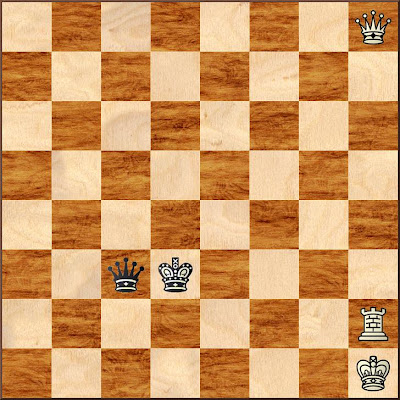This week's lesson concerns a quick loss that Siegbert Tarrasch suffered at the hands of a local chess master in his hometown of Breslau.
Tarrasch,Siegbert -- Riemann,Fritz [C67]
Breslau, 1879
1.e4 e5 2.Nf3 Nc6 3.Bb5 Nf6 4.0–0 Nxe4 5.d4 Be7 6.Qe2 Nd6 7.Bxc6 bxc6 8.dxe5 Nf5 9.g4 Nh4 10.Nxh4 Bxh4 11.f4 Be7 12.f5 d5 13.f6 Bc5+ 14.Be3 Bxe3+ 15.Qxe3 gxf6 16.exf6+ Be6 17.Kh1 Rg8 18.g5
Black to move
Riemann played 18...d4 and Tarrasch resigned.
Why did he resign? How was Black planning to finish the game?
During the school year 2012-2013, my weekly lessons have all come from the games of a small number of select players who were instrumental to the beginnings of strategic chess play slightly more than a century ago. From September to the end of October, lessons came from the games of Akiba Rubinstein. Rubinstein has been called, "the most brilliant" proponent of the Steinitz School (one name for the revolution in chess theory that began in the late-nineteenth century).
In November and December, lessons came from the games of Paul Morphy. Morphy was active in the 1850s before positional concepts (development was a key idea for the Steinitz School) were articulated. However, Morphy's play reveals that he understood these ideas that would be articulated by a later generation. Known for his brilliant attacks against the king, Morphy was able to achieve these victories because he routinely developed all of his pieces quickly.
From the beginning of January, lessons have come from the games of Siegbert Tarrasch, who articulated the concepts first set out by Steinitz (but practiced by Morphy). Tarrasch's Dreihundert Schachpartien (1896) translated as Three Hundred Chess Games (1999) has been one source for theses lessons. When Rubinstein was beginning to take a serious interest in chess as a youth, he studied Dreihundert Schachpartien. Several of Tarrasch's later victories are illustrative games in the classic text, Logical Chess: Move by Move (1957) by Irving Chernev. Some lessons have come from this book.
Ideally, lessons from these players could introduce young players to the elements of strategic thinking as well as honing their tactical vision. That is my hope. However, most of the young players overlook simple pins, forks, decoys, and skewers. In order to train beginning players in simple tactics, I have developed a series of worksheets featuring artificial positions with ten pieces or fewer. Some students struggle to finish these worksheets.
Beginning Tactics 14
Find the best move for White in each diagram.
























No comments:
Post a Comment